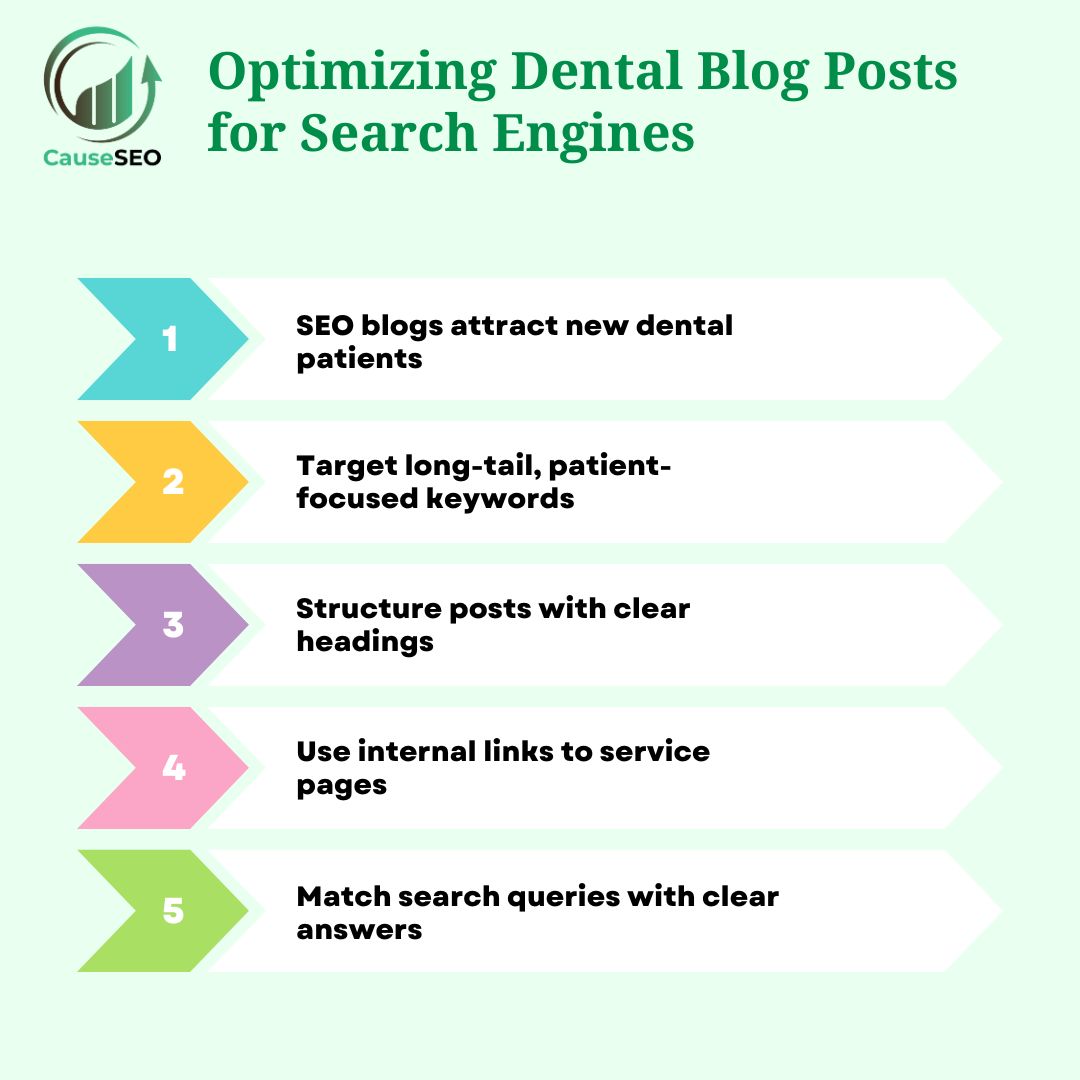Imagine a potential patient looking for help with a dental problem. They search for something like “how to stop tooth pain at night” and land on your blog. That moment, where your content provides the answer they need, is why optimizing dental blog posts is essential for dental practices in 2025.
Blog posts are no longer just optional extras. They are a vital part of dental website SEO. When done right, they help your site appear in search results, attract new visitors, and guide those visitors toward becoming patients. They also support your service pages and improve your overall visibility online.
This article will walk through the key parts of successful dental blog optimization. You will learn how to choose the right keywords, structure your posts, write content that connects with real patient questions, and follow technical best practices that help your posts perform better in search. Each section is designed to help your dental blog bring in real results.

Why SEO Matters for Dental Blog Content
Organic Visibility Brings New Patients
When people search online for answers to dental problems—like “how to stop gum bleeding at home” or “what to do after tooth extraction”—they’re often in a research phase. These long-tail search queries give dental practices the chance to appear at just the right moment.
Blogs optimized for search engines are more likely to rank for these specific phrases. By being present in these micro-moments, your content builds trust with potential patients before they even visit your office.
Blogs Strengthen Overall Site SEO
Publishing blog content regularly tells search engines that your site is active and relevant. This can lift your entire website’s visibility, not just individual blog posts.
Additionally, internal links from blog posts to core service pages (like teeth cleaning or braces) help Google understand the structure of your site. This supports both patient navigation and your overall SEO for dental office pages.
Keyword Research for Dental Blog Topics
How to Find the Right Keywords
Start with tools like Google Keyword Planner, Ahrefs, or Ubersuggest to discover what people are searching for. Focus on long-tail and local queries such as “best dentist for kids in Houston” or “toothache remedy at night.”
Question-based keywords are especially effective. Think of topics your patients ask about all the time. These are the perfect foundation for blog posts.
Matching Keywords to Patient Intent
It’s important to know the difference between informational and commercial search intent.
- Informational keywords: “how to prevent cavities” or “foods that stain teeth”
- Commercial keywords: “dentist open on weekends” or “affordable root canal near me”
Use blog posts to target informational keywords, but don’t miss the chance to support your services by linking back to relevant pages.
Where to Place Keywords Strategically
Your primary keyword—like “dental SEO”—should appear in the:
- Title tag
- Meta description
- H1 and H2 headings
- First 100 words
- Image alt text
Avoid keyword stuffing. Focus on natural integration and make sure it fits the context of what you’re writing.

Structuring Blog Posts for SEO and Readability
Use of Headings and Subheadings
Break your blog post into logical sections using H2 and H3 headings. This makes it easier for readers to scan and for search engines to understand the content.
Avoid long paragraphs. Use bullet points, lists, and subheadings to keep your post digestible.
Meta Title and Description Optimization
Your title should include your main keyword and stay under 60 characters. The meta description should be under 155 characters and encourage clicks.
For example:
- Title: “Top 5 Teeth Whitening Tips from Dentists”
- Meta: “Want a brighter smile? These dentist-approved tips for teeth whitening work fast and are easy to follow. Learn more at CauseSEO.com.”
URL Structure and Internal Linking
Keep URLs clean and short. For example:
/blog/best-floss-for-braces
Link blog posts to your main services. If you’re writing about gum health, link to your deep cleaning or periodontal care page with a line like: “Learn more about our gum disease treatments.”
Writing High-Quality Blog Content That Ranks
Match the Patient’s Search Query Exactly
When someone types a question into Google, they want a straight answer. Get to the point early in your blog.
Use bullet points, summaries, and a clear structure. If the question is “What helps with tooth pain?”—answer it in the first paragraph, then expand.
E-E-A-T: Experience, Expertise, Authoritativeness, Trustworthiness
Google values trustworthy content. Add a short author bio noting dental credentials or practice experience. Back up medical claims with links to reputable sources like the ADA or CDC.
This not only builds trust with readers—it also boosts credibility in search engine rankings.
Image, Video, and Schema Enhancements
Use original photos or diagrams when possible. Include alt text that describes the image in context.
Adding a quick explainer video or how-to diagram can improve engagement. You can also use schema markup (especially FAQ schema) to improve how your post appears in search results.
Technical SEO Best Practices for Dental Blog Posts
Mobile Optimization and Page Speed
Most users visit your blog from a phone. If it loads slowly or isn’t mobile-friendly, they’ll bounce—and so will your ranking.
Use Google’s PageSpeed Insights to test performance and keep your design responsive across devices.
Proper Use of Canonical Tags and Indexing
Make sure your blogs are indexed properly by Google. Use canonical tags if similar content exists, and ensure pages are crawlable by checking your XML sitemap and robots.txt file.
Optimize for Voice Search (Optional)
People use voice assistants to ask dental questions like “How do I stop a tooth from hurting?” Use conversational, natural language throughout your content to help it show up in these searches.

FAQs About Optimizing Dental Blog Posts
How long should a dental blog post be for SEO?
A good range is 800–1200 words. The goal is to cover the topic clearly and thoroughly—not just meet a word count.
How often should dentists publish blogs?
Aim for at least two to four posts per month to build momentum.
Can I write blogs without targeting keywords?
You can, but you’ll miss out on visibility. Keywords guide search engines to your content.
Do blogs really bring in new dental patients?
Yes—especially when they answer local and specific questions people search online.
Should I hire an SEO writer or write blogs myself?
Hiring a dental SEO expert ensures quality and optimization. But if you understand SEO basics, writing your own is possible too.
Conclusion
Optimizing blog posts is one of the most effective strategies in dental SEO today. It helps your practice stay visible online, earn trust, and bring in new patients—all through useful, educational content.
As search algorithms evolve and user experience becomes more important, now is the time to start publishing content that reflects both what people are searching for and how they prefer to read it.
Visit CauseSEO to speak with a dental SEO expert and learn how optimized blog content can grow your practice.

